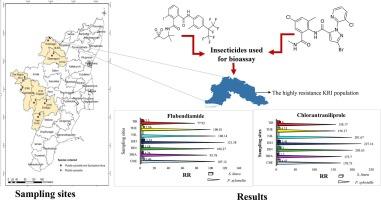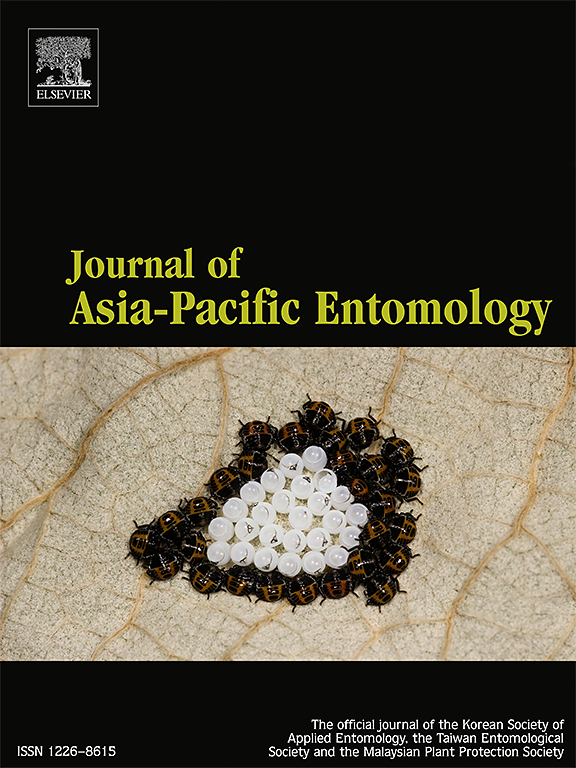以油菜为食的小菜蛾和斜纹夜蛾田间种群对二胺的敏感性不同
IF 1.1
3区 农林科学
Q3 ENTOMOLOGY
引用次数: 0
摘要
二胺类杀虫剂是一种新型杀虫剂,已经在印度农业中使用了15年以上。小菜蛾(Plutella xylostella L.)和叶虫(Spodoptera litura Fab.)发病率较高。在印度南部卷心菜/花椰菜上大量应用了二胺。前者是寡食(专门性)害虫,后者是多食(通才性)害虫。在印度,DBM对二胺类化合物的抗性已经出现,但对S. litura没有。对泰米尔纳德邦不同农业气候带的菜花和卷心菜采集的田间种群进行了抗虫性测试,即氟苯二胺和氯虫腈。结果表明,田间种群对氟虫胺和氯虫腈的抗性较高(分别为98.32 ~ 54.52 mg/L),而对斜纹夜蛾的抗性较低(4.84 ~ 0.84 mg/L)。两种害虫对氯虫腈的抗性倍数均较高,对氟虫胺的抗性倍数均高于对氟虫酰胺的抗性倍数。对氟虫胺(121.38)和氯虫腈(227.16)的抗性折叠与参考敏感群体(sus - 1)进行比对,得到了多重折叠。在亚致死二胺暴露后,高抗性DBM群体的解毒酶(MFO, GST, CarE)分析显示GST过表达长达24小时,而在S. litura中没有测试酶一致表达。此外,小菜蛾的ryanodine受体结合位点(G4946E)存在点突变,而斜纹蛾则不存在。寡食似乎有利于DBM的耐药积累,而多食则淡化了斜纹葡萄的耐药发展。DBM种群可能需要有效的抗性管理干预来解决代谢解毒和点突变。本文章由计算机程序翻译,如有差异,请以英文原文为准。

Susceptibility to diamides differs in the field populations of Plutella xylostella and Spodoptera litura feeding on cole crops
Diamides, a new class of insecticides, have been used in Indian agriculture for more than 15 years. The severe incidence of diamondback moth (DBM), Plutella xylostella L., and leafworm, Spodoptera litura Fab. on cabbage/cauliflower drew intensive applications of diamides in Southern India. The former is an oligophagous (specialist), while the latter is a polyphagous (generalist) pest. In India, DBM resistance to diamides has surfaced, but not for S. litura. The field populations collected from cauliflower and cabbage in Tamil Nadu’s various agro-climatic zones were tested for diamides resistance, viz., flubendiamide and chlorantraniliprole. The results revealed high resistance to flubendiamide and chlorantraniliprole in DBM field populations (98.32 to 54.52 mg/L, respectively) but not in S. litura (4.84 to 0.84 mg/L). Resistance fold in both pests were high for chlorantraniliprole rather than flubendiamide, and the KRI population stood top in resistance. The Resistance folds to flubendiamide (121.38) and chlorantraniliprole (227.16) got multi-folded for DBM when matched against reference susceptible population (SUS-I). Analysis of detoxifying enzymes (MFO, GST, CarE) in highly resistant DBM populations after sub lethal diamide exposures showed GST over-expression for up to 24 h, while none of the tested enzymes consistently expressed in S. litura. Further, there was a point mutation at the ryanodine receptor binding site (G4946E) in P. xylostella, which was absent in S. litura. Oligophagy seems to favour resistance build-up in DBM, while polyphagy downplays resistance development in S. litura. Populations of DBM may require effective resistance management intervention to address metabolic detoxification and point mutation.
求助全文
通过发布文献求助,成功后即可免费获取论文全文。
去求助
来源期刊

Journal of Asia-pacific Entomology
Agricultural and Biological Sciences-Insect Science
CiteScore
2.70
自引率
6.70%
发文量
152
审稿时长
69 days
期刊介绍:
The journal publishes original research papers, review articles and short communications in the basic and applied area concerning insects, mites or other arthropods and nematodes of economic importance in agriculture, forestry, industry, human and animal health, and natural resource and environment management, and is the official journal of the Korean Society of Applied Entomology and the Taiwan Entomological Society.
 求助内容:
求助内容: 应助结果提醒方式:
应助结果提醒方式:


